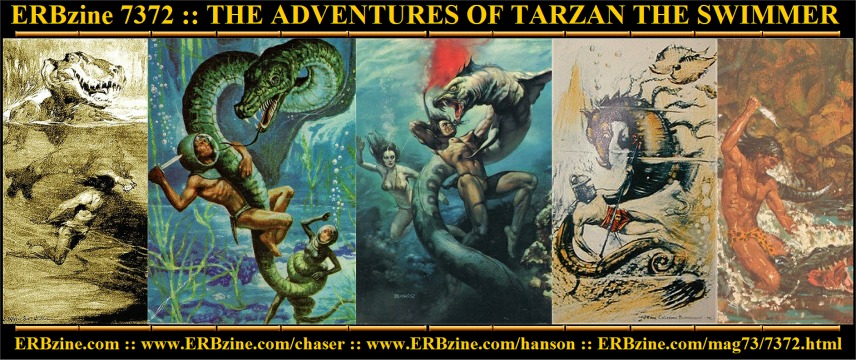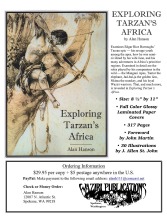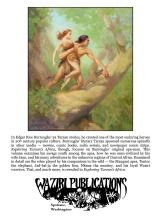
Tarzan the Swimmer
His Adventures in Rivers, Lakes, and Oceans
by Alan Hanson
 Once I discovered the real Tarzan of the Apes in the stories
of Edgar Rice Burroughs, I never had much use for the ape-man’s various
Hollywood incarnations. Other than the Disney animated feature (which I
only saw once), I haven’t viewed a Tarzan movie in over 40 years. As a
teenager in the ’60s, though, I admit watching a handful of the Weissmuller
Tarzan films, which were dreary compared to Burroughs's literary ape-man.
Once I discovered the real Tarzan of the Apes in the stories
of Edgar Rice Burroughs, I never had much use for the ape-man’s various
Hollywood incarnations. Other than the Disney animated feature (which I
only saw once), I haven’t viewed a Tarzan movie in over 40 years. As a
teenager in the ’60s, though, I admit watching a handful of the Weissmuller
Tarzan films, which were dreary compared to Burroughs's literary ape-man.
One of the images that surfaces when thinking about those
Tarzan films seen years ago is that of Tarzan swimming. In an attempt to
capitalize on Weissmuller’s renown as an Olympic champion, the producers
naturally included scenes of Tarzan swimming in jungle rivers. But was
the real Tarzan — ERB’s Tarzan — comfortable and accomplished in the water?
In water, the literary Tarzan was certainly out of his
primary element. In addition to pathways for swift travel, trees provided
Burroughs’ ape-man with concealment to observe and prey upon beasts and
humans in the forest. By comparison, Tarzan was vulnerable when in the
water, and nearly perished several times when Burroughs dropped him into
rivers, lakes, and oceans. As expected, though, the ape-man’s strength
and courage always allowed him to survive his watery misadventures.
Scenes of Tarzan in the water appear in 11 Burroughs stories
running the length of the ape-man’s recorded life. The perils of Tarzan
the swimmer are recounted below.
Tarzan of the Apes
For the first 10 years of his life,
Tarzan hated and feared being in the water. He associated it, said Burroughs,
with the “chill and discomfort of the torrential rains, and he feared
it for the thunder and lightning and wind which accompanied them.”
He could not swim, and, after watching “little Neeta” drown in a
jungle lake, had no desire to learn the skill.
According to ERB, though, the same assets that allowed
Tarzan to survive in his primitive world led to him learning how to swim.
“His life amidst the dangers of the jungle had taught him to meet emergencies
with self-confidence, and his higher intelligence resulted in a quickness
of mental action far beyond the powers of the apes.” So when a lioness
charged little Tarzan and one of his “cousins” from behind on a
lakeshore, the ape-boy instinctively launched himself into the deep water.
Self-preservation sent him into the water, but it was
his resourcefulness that kept him alive there. “Rapidly he moved his
hands and feet in an attempt to scramble upward, and, possibly more by
chance than design, he fell into the stroke that a dog uses when swimming,
so that within a few seconds his nose was above water and he found that
he could keep it there by continuing his strokes, and also make progress
through the water.”
The episode ended Tarzan’s fear of water and replaced
it with a “feeling of freshness and exhilaration.” As a result,
“ever after he lost no opportunity to take a daily plunge in lake or
stream or ocean when it was possible to do so.”
The Return of Tarzan
At age 21, Tarzan took a “plunge”
not of his own choosing into the Atlantic Ocean. It challenged his self-confidence,
resourcefulness, and physical stamina to survive the incident. It started
one evening when the Russian villains Rokoff and Paulvitch pitched Tarzan
overboard from a passenger liner headed south along the west coast of Africa.
After swimming clear of the ship’s propellers, the ape-man
started swimming slowly toward the coast, though he had no idea how far
away it was. “His strokes were long and easy — it would be many hours
before those giant muscles would commence to feel fatigue. As he swam,
guided toward the east by the stars, he noticed that he felt the weight
of his shoes, and so he removed them. His trousers went next … Before many
hours he had divested himself of his remaining garments, and was swimming
easily and unencumbered toward the east.”
At dawn he found and crawled aboard a “wave-washed
derelict” and slept until “early in the forenoon.” When he awoke,
he found an overturned lifeboat floating nearby. After swimming to the
lifeboat, he was able to right it and paddle to the very beach on which
set the cabin of his childhood. He spent that night in the cabin, and the
next morning “he took a plunge into the sea, swimming about for a quarter
of an hour.”
The Beasts of Tarzan
Twice, at great peril to his life,
Tarzan entered the crocodile infested waters of the Ugambi River during
his search for his abducted wife and son in ERB’s third Tarzan story. When
he spotted Rokoff, his family’s nemesis, floating down the river in a native
boat, the maddened ape-man dove “fearlessly into the forbidding waters
of the tropical river. With steady, powerful strokes the ape-man forged
out into the stream toward the drifting dugout … Tarzan had reached the
stern of the craft at last. One hand upstretched grasped the gunwale …
Then a sudden commotion in the water behind the swimmer caught his attention.
He saw the ripple, and knew what caused it. At the same instant Tarzan
felt mighty jaws close upon his right leg … There was a short struggle
at the surface, and then a swirl of waters, a little eddy, and a burst
of bubbles soon smoothed out by the flowing current marked for the instant
the spot where Tarzan of the Apes, Lord of the Jungle, disappeared from
the sight of men beneath the gloomy waters of the dark and forbidding Ugambi.”
As the crocodile dragged Tarzan to its lair far under
the riverbank, the age-man used his knife to dispatch the creature. He
realized the only way back to the surface was to retrace the underwater
route the crocodile had used to bring him there. “Filling his lungs
with the close and reeking air of the chamber, Tarzan of the Apes dived
into the dark and watery hole which he could not see but had felt out and
found with his feet and legs … Rapidly he crawled and swam through the
passage which inclined downward and finally upward to open at last into
the river bottom but a few feet from the shore line.”
Tarzan then continued downriver along the bank in pursuit
of Rokoff. In the dark he heard gunfire and a woman’s scream coming from
somewhere out on the river. Despite the wounds on his leg from his earlier
encounter with the crocodile, Tarzan did not hesitate. “With a bound
he cleared the intervening bush — there was a splash as the water closed
about him — and then, with powerful strokes, he swam out into the impenetrable
night with no guide save the memory of an illusive cry, and for company
the hideous denizens of an equatorial river.”
The memory of what happened the last time he swam in the
Ugambi caused a “sudden shudder” to shake his body, and twice he
felt “something brush his legs from the slimy depths below.” He
swam unimpeded, however, until his hand touched a ship anchored in mid-stream.
Soon after boarding the Kincaid, he was reunited with Jane and saw Sheeta
kill Rokoff.
Tarzan and the Jewels
of Opar
After suffering memory loss due
to a head injury in a rockslide, Tarzan wandered through the dark recesses
leading into Opar. He had followed the route before but did not remember
the open well that interrupted the rocky trail. “He reached the brink
of the well, stepped outward into space, lunged forward, and shot downward
into the inky depths below. Still clutching his spear, he struck the water,
and sank beneath its surface, plumbing the depths.” Fortunately, Tarzan’s
memory loss did not include how to swim. “The fall had not injured him,
and when he rose to the surface, he shook the water from his eyes, and
found that he could see … On the level with the surface of the water he
saw a large opening in the dank and slimy wall. He swam to it, and drew
himself out upon the wet floor of a tunnel.”
Later in the story, following his escape from Opar, the
retrieval of his memory, and his return to the jungle, Tarzan awoke one
morning and took a “plunge in the river” before breakfast. It recalls
Burroughs’s assertion in Tarzan of the Apes that since childhood
the ape-man “lost no opportunity to take a daily plunge.”
Tarzan the Terrible
Trapped in the temple of A-lur
in Pal-ul-don, Tarzan’s only hope of escaping a charging gryf was to dive
into the creature’s drinking pool. When the gryf splashed into the water
in pursuit, Tarzan swam with “swift, bold strokes” toward an opening
in the cliff wall on the opposite side of the pool. “The ape-man threw
all the resources of his great strength into the last few strokes, extended
his hands before him as a cut-water, submerged to the water’s level and
shot forward toward the hole. … Tarzan’s sleek brown body cutting
the moonlit water shot through the aperture in the wall of the pool and
out into the lake beyond.”
Swimming silently in the moonlight, Tarzan searched for
another opening in the cliff through which he could reenter the temple.
When he found a gap at water level, he “carefully raised his body to
the threshold of the entrance-way, his smooth brown hide glistening in
the moonlight as it shed the water in tiny sparkling rivulets.” Back
on solid ground, Tarzan moved down a gloomy, unlit passageway to continue
his search for Jane.
Tarzan the Invincible
After saving Zora Drinov from the
clutches of a great ape, Tarzan nursed the weak Russian girl for several
days in the jungle. When she had recovered her strength, the ape-man decided
to take her back to the base camp of the invading conspirators. During
that trip, Burroughs included the following paragraph describing how Tarzan
crossed a jungle river.
“At the edge of the river that they had crossed before,
Tantor was awaiting them, and once more he carried Zora and Tarzan safely
to the other bank. Tarzan himself had crossed the river twice a day since
he had made the camp for Zora; but when he went alone he needed no help
from Tantor or any other, for he swam the swift stream, his eye alert and
his keen knife ready should Gimla, the crocodile, attack him.”
Tarzan and the Lion Man
As with Zora in Invincible, Tarzan
was returning Rhonda Terry to her Hollywood film company after saving her
from English-speaking gorillas. To avoid the hippopotamuses and crocodiles
in the water below Omwamwi Falls, Tarzan decided to cross the swift current
above the falls. He told the girl to hold on tight to his shoulders.
“He plunged in and struck for the opposite shore, while
the terrified girl clung to him in desperation. The farther bank looked
far away indeed. Below she could hear the roar of the falls. They seemed
to be drifting down toward them. But presently the strong, even strokes
of the swimmer reassured her. He seemed unhurried and unexcited, and gradually
she relaxed as though she had absorbed a portion of his confidence. But
she sighed in relief as he clambered out on solid ground.”
Tarzan and the City
of Gold
Tarzan’s powerful strokes were
of little use when floodwater swept him down a river in the Valley of Onthar.
While trying to cross the fast moving current in waist high water, he stepped
into a hole and was swept away. Tarzan tried to swim to the opposite bank,
but he was powerless in the swirling current.
“Finding even his great strength powerless and weakening,
Tarzan gave up the struggle to reach the opposite bank and devoted his
efforts to keeping his nose above the surface of the angry flood. Even
this was none too easy of accomplishment, as the rushing waters had a trick
of twisting him about or turning him over. Often his head was submerged,
and sometimes he floated feet first and sometimes head first; but he tried
to rest his muscles as best he could against the time when some vagary
of the torrent might carry him within reach of the bank upon one side or
the other.
“As Tarzan battled for his life in the swirling waters
of the swollen river he lost all sense of time; the seemingly interminable
struggle against death might have been enduring without beginning, might
endure without end, in so far as his numbed senses were concerned. His
efforts to delay the apparently inevitable end were now purely mechanical,
instinctive reactions to the threat against self-preservation. The cold
water had sapped the vitality of his mind as well as of his body, yet,
while his heart beat, neither would admit defeat; subconsciously, without
active volition, they sought to preserve him.”
The river threw him first toward one bank and then to
the other. Reaching out, he was finally able to grab and hold on to a heavy
vine hanging down in the water. “Hand over hand the man dragged himself
out of the water and onto the bank, where he lay for several minutes.”
For Tarzan that night, it was much more a struggle for survival than a
swim in the river. Still, if he hadn’t been a strong swimmer, he certainly
would never have escaped the grip of that floodwater.
Tarzan and the Forbidden
City
Tarzan spent more time in the water
in Forbidden City than in any other Burroughs story. It started
when the boat carrying him and his companions was rammed by an Asharian
galley, throwing all the occupants into the dark water of a river leading
to Lake Horus. “Tarzan had swum beside Magra, encouraging and supporting
her” until they were taken aboard an Asharian ship as prisoners. Later,
after escaping captivity in Ashair, Tarzan, wearing a water suit and helmet,
made several walking excursions along the bottom of Lake Horus.
One episode in the story demonstrated Tarzan’s confidence
— perhaps over-confidence in this case — in his ability to survive swimming
in predator infested waters. Having escaped Ashair, the ape-man and two
companions decided to try returning to the city to rescue their friends,
who were still imprisoned there. First, they needed a boat to get to the
city. Tarzan had a simple plan to get one. “When it is dark, I’ll swim
to Ashair and steal a boat from the quay there,” he told his companions.
They both objected. “You wouldn’t get half way across, swimming on the
surface,” said one. “Don’t do it, Tarzan,” pleaded the other.
“You would just be throwing your life away uselessly.” Tarzan brashly
declared, “I do not intend to throw my life away at all. I have my knife.”
After dark, Tarzan entered the lake. He had covered about
half the distance to Ashair when disaster threatened him on two fronts.
First, he was spotted by galley full of warriors. To elude them he dove
underwater and swam away. But when he rose toward the surface for air before
diving again, and even greater menace confronted him.
“He saw a shadowy form approaching him; and knew that
at last the thing that Helen and Herkuf had so feared had happened. He
recalled his words of assurance to them, ‘I have my knife,’ and half smiled
as he drew it. As the great shark turned on its back to seize Tarzan, he
plunged his knife into its belly and ripped it open for a distance of several
feet. Mortally wounded, the great fish thrashed about in its agony … The
ape-man, avoiding the lashing tail and angry jaws of the shark, now saw
other great forms converging upon them, silent, sinister tigers of the
deep attracted at first, like their fellow, by the light of the torch in
the bow of the galley; but now by the blood of the wounded shark.
“His lungs bursting, Tarzan swam toward the surface
for air, confident that the wounded shark would occupy the attention of
the others. He knew, from the radiance of the water, that he would come
up close to the galley; but he had to choose between that and death from
drowning; there was no other alternative. As he broke the surface of the
water, he was close beside the galley; and warriors seized him and drew
him over the gunwale.”
The Quest of Tarzan
After being captured by Mayans
on a South Seas island, Tarzan faced death in an ancient form of ritual
sacrifice. A pre-dawn procession carried him to the crater of an inactive
volcano, where, at dawn, his bonds were cut and he was dropped some 70
feet into the water below. Tarzan found himself in a pool “about a hundred
feet in diameter with perpendicular sides of smooth volcanic glass.”
From the rim of the crater, Patricia Leigh-Burden, also
a Mayan captive, called down to him, “Tarzan, I know this form of sacrifice
well … The victim was thrown into the sacred well at Chichen Itza at dawn,
and if he still lived at noon, he was taken out and raised to highest rank;
he became practically a living god on earth.”
The ape-man then turned over and began swimming slowly
around in the pool’s chilly water. “Tarzan swam just strongly enough
to keep from becoming chilled,” Burroughs noted. When the sundial marked
noon, he was still swimming. Hand over hand, Tarzan climbed a provided
vine from the pool’s surface to the crater’s rim. There “the people
fell to their knees before him and supplicated him for forgiveness.”
Tarzan and “The Foreign
Legion”
The ape-man’s final adventure in
the water occurred in the closing pages of the last Tarzan story published
during ERB’s lifetime. The boat carrying Tarzan and his companions across
the Indian Ocean from Sumatra toward Australia was blown out of the water
by a shell from a Japanese ship. The explosion threw Tarzan some distance
away. Uninjured, he was swimming toward two American airmen in the water,
when he was warned about a danger approaching from below:
“Diving quickly beneath the surface, he drew his knife.
A few swift, strong strokes brought him close to the shark. A mighty surge
of his knife arm ripped open the belly of the huge fish, disemboweling
it. It … turned on Tarzan, but the man eluded its jaws and struck again
and again with his knife. The water was red with blood as another shark
darted in and attacked its fellow. The first shark swam sluggishly away
while the other bit and tore at it. For the moment the survivors were freed
from one menace, but the bullets still pinged close.”
A British submarine sank the enemy ship and took Tarzan
and the other survivors aboard. As the sub steamed over the horizon toward
Australia, the adventures of Tarzan of the Apes on land and sea came to
an end.
Summary
In summary, then, Tarzan of the Apes
— the one created by Edgar Rice Burroughs — taught himself to swim at age
10 and enjoyed recreational swimming on a daily basis, when possible, for
the rest of his life. In Burroughs’ stories we see the ape-man swim in
several African rivers and lakes, as well as in the Atlantic and Indian
Oceans. Burroughs described Tarzan’s swimming stroke as being “swift,”
“bold,” “strong,” and “powerful,” indicating speed
in the water that might have rivaled Weissmuller’s. His daily dips and
great strength also gave him the stamina of a long-distance swimmer, allowing
him to survive hours of ocean swimming in The Return of Tarzan
and in the Mayan sacrificial well.
Clearly, though, Tarzan was much more vulnerable to predators
in the water than he was on land. Three-quarters of his arsenal of weapons
— rope, spear, and bow and arrows — were useless in the water, leaving
him only his knife to fend off attackers. He was extremely lucky to survive
the attacks of the crocodile in The Beasts of Tarzan and
the gryf in Tarzan the Terrible.
Burroughs’ Tarzan was clearly most at home on land, and,
in particular, most powerful in the trees of his African forests. The self-confidence,
courage, and resourcefulness that made him nearly invulnerable on land,
however, also allowed him to survive battles in the water. His ability
to face all of life’s challenges with those three basic traits was the
allure, I suspect, that drew millions of readers to the Tarzan stories.
The End



![]()
 .
. .
.
![]()
![]()
![]()
![]()
![]()
![]()

![]()